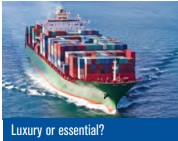One subject has, until now, been neglected in the columns I have written for ASHRAE Journal despite the fact that it is one of the oldest applications of refrigeration and has been developed over the last two centuries into a technology of extreme sophistication and global significance.
The subject is transport refrigeration and the history of this technology began with Thomas Moore’s icebox, which he called a “refrigerator,” patented in 1803. Moore used his box, a wooden chest containing an iron tub, to carry butter on horseback to market, using ice packed around the tub to provide the cooling. He estimated that only four or five trips to market were required to pay back the capital investment in his system, given the massive premium that he was able to charge for his butter because of the excellent condition in which it was presented to the purchasing public.
Over the next century these mobile refrigerators got bigger, including several variants of railcars using packed ice or salt-ice mixtures. These iced railcars enabled the massive growth of Chicago as a meatpacking center since cattle could be transported live from all over the Midwest, butchered and dressed at the Chicago stockyards and then shipped across the Eastern seaboard. Further south the development of Georgia as the Peach State was largely facilitated by iced railcars distributing the fruit harvest over thousands of miles. In California, the Continental Fruit Express and the Pacific Fruit Express operated many thousands of these “reefers” to bring fruit to the east. By the end of the 19th century well over a million tons a year of ice was used for these refrigerated rail transports. Similar developments occurred in Russia where food was shipped equally long distances, but they were less common in Europe where shorter journey times enabled growers to get by without so much ice assistance.
Although a mechanically refrigerated reefer was demonstrated in 1888, the use of ice persisted until the late 1950s when mechanical cooling units were introduced more widely. The last ice-cooled reefers were taken out of service in the USA in the early 1970s. This coincided with the introduction of intermodal transport; the rise of the shipping container and the development of compact and robust refrigeration units. The technology embedded in these wonders of modern engineering spans a wide array of requirements. Of course the systems need to be extremely reliable. They may be at sea for months without any maintenance intervention and the value of the container contents—far in excess of the value of the container—is totally dependent on the refrigeration unit’s continued operation. They also need to be rugged.
Operation must be assured over a wide range of conditions ranging from storms at sea to bumpy dirt tracks far from paved roads and in ambients from arctic to equatorial, sometimes in the same voyage. Flexibility is required. The refrigeration unit is electrically driven with power usually supplied by an onboard gen-set or from an external electrical supply point. Many units can be plumbed into a cooling water system to ensure continued operation if they are stowed below decks on a long sea voyage where their air-cooled condenser would be inoperable. The units also have to flex between carrying fresh and frozen product, sometimes in the same shipment, and the load might also require humidity control or ventilation.
These modern marvels have transformed the cold chain. Long range food shipment is sometimes cast as a luxury item, enabling us to enjoy fresh, exotic produce out of season. However, it is much more than this and is an essential part of the modern, urban, industrialized world. Urban growth over the next 30 years will ensure it remains a critical service in reducing food wastage and ensuring security of supply for the
foreseeable future.

